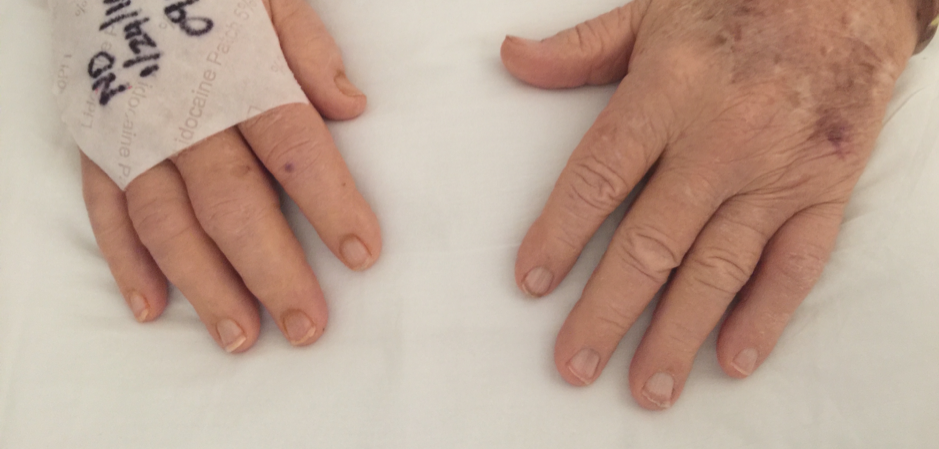Case Presentation: An 85-year-old gentleman who was started on intra-vesical BCG therapy for Tis staged bladder cancer presented to the hospital with excruciating asymmetric polyarticular joint pain.He previously completed induction therapy successfully, during which he had developed cystitis. Subsequently, the patient received 3 doses of maintenance therapy, and on day 5 after his last dose he developed pain and swelling bilaterally involving both wrists and hands. Before presenting to our hospital, he was treated with oral prednisone which provided transient relief. He subsequently experienced bouts of swelling and pain in multiple joints. He received colchicine which provided minimal relief and was started on anti-TB medications (namely, rifampin, ethambutol, isoniazid and pyridoxine) for possible disseminated TB. On arrival to our hospital, he complained of persistent polyarticular pain. He denied fever/chills/cough, urinary symptoms, constipation/diarrhea, ophthalmic symptoms or history of travel outside of the United States.
Discussion: BCG (Bacillus Calmette Guerin) is a live attenuated form of Mycobacterium bovis and is commonly used for intravesical therapy in management of Ta, Tis and T1 staged bladder cancers. BCG acts by triggering a variety of local immune responses, including induction of CD4 T cells and macrophages, increased IFN-gamma and elevated cytokines.The incidence of oligo or poly-articular involvement secondary to therapy is infrequent and described in 0.5-1% of the patients compared to other more common side effects such as, cystitis (90%), urethritis, uveitis and conjunctivitis. Our patient’s radiographs did not show any acute osseous deformities. Right shoulder MRI was found to be consistent with acute exacerbation of acromio-clavicular joint degenerative arthritis accounting for subchondral and soft tissue edematous reactive changes which is consistent with antimycobacterial therapy.Laboratory tests for rheumatologic pathologies were insignificant for ANA, anti-dsDNA, anti-CCP, RF, and ANCA in blood. HLA typing revealed patient was B27 positive. Inflammatory markers, ESR (>190) and CRP (9.93) were found to be elevated. Synovial fluid aspirate was negative for crystals, but had an elevated white cell count (12,750) with predominant neutrophilia (88%). Synovial tissue biopsy showed focal necrosis and chronic inflammatory infiltrate. Histologic findings were non-specific and indicated towards an infectious or an inflammatory process. Disseminated TB was ruled out with AFB staining and culture of the synovial fluid.Taking into account the above test results and an acute onset of symptoms within the first week after the most recent intravesical BCG, patient was diagnosed with reactive arthritis secondary to BCG. The patient initially received methyl-prednisone and NSAIDs (ketorolac and Naproxen) along with continuation of antimycobacterial therapy. Sulfasalazine was added to the regimen to control inflammation along with tizanidine for spasms.
Conclusions: Cystitis is the most common adverse effect from intra-vesical BCG vaccine, however, on rare occasions, patients may develop other inflammatory response, like severe arthritis. These adverse effects do not always occur after the initial exposure during induction therapy and may consequently happen during maintenance phase. Therapeutic options may be limited in patients with pancytopenia and MGUS as commonly used agents for this condition such as methotrexate are contraindicated.

